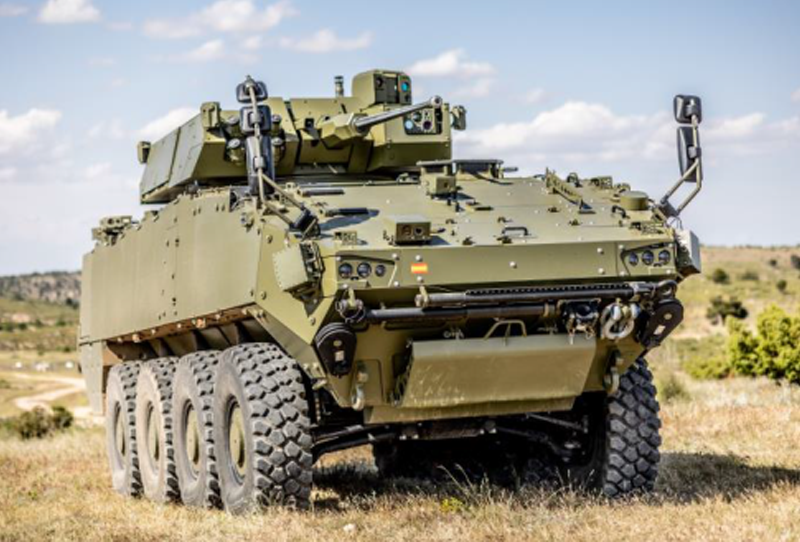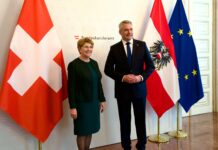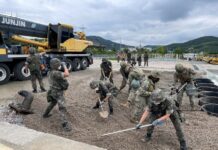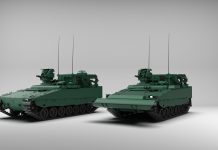There is a vibrant and often underestimated capability among the roughly 50 manufacturers and suppliers, but can, or should a neutral country that prides itself on humanitarianism justify exporting arms at all?
Reasons for the Swiss Defence Industry
It is a noble task to give states the right to defend themselves. We are not warmongers, we are realists. The world will not become a more peaceful place without our air defence systems. “Fortunately, the Swiss Government in Bern still tries to differentiate between defensive and offensive weapons…” says Fabian Ochsner (CEO Rheinmetall Air Defence).
This statement characterises more or less the main synopsis around the Swiss defence industry’s national and international standing, in a country globally renowned for its precision mechanics and watchmakers. Permanent pressure from civil society has forced Swiss policymakers into action, since there were repeated high profile cases in recent years of weapons exported from Switzerland ending up in the wrong hands. For example, Swiss hand grenades originally delivered to the UAE in 2003 were found to have been used in the Syrian civil war. Or Pilatus PC-9 turboprop-trainers were photographed in Chad carrying 125 kg unguided dumb bombs.
Over the last decade, the Swiss Government quotes the number of employees in the Swiss armaments industry at approx. 10,000, and with suppliers, roughly 20,000. In a communiqué last year, the Swiss Federal Council (Bundesrat) still described this industrial base as “comparatively strong”. But as in several other European countries, hardly anyone would deny that the Swiss Army is already highly dependent on foreign suppliers today. Crucially, the classic Swiss armaments industry largely did not survive the end of the Cold War. Switzerland, among other things for example – and with the F-35 yet again – relies on American fighter jets, French COUGAR transport helicopters, Israeli HERMES reconnaissance drones and Swedish infantry combat vehicles. In attempts at self-reliance, Switzerland over the decades has experienced some debacles with expensive taxpayer-supported self-made projects. There was the P-16 fighter aircraft, the procurement of which was cancelled in favour of the British Hawker HUNTER in 1958 after a second prototype crashed into Lake Constance. Or the ultimately unusable MBT Kampfpanzer 68, which caused a scandal and a lot of ridicule in the 1970s. On the other hand, the Assault Rifle 90 is considered a success, but after this, the Army will probably have to procure its successor abroad as well, because the former OEM Schweizerische Industrie-Gesellschaft (SIG) in Neuhausen in 2000 has ceased production.
A Lot of Know-How Given Away
In almost all of the following examples, there is still considerable know-how and expertise at those manufacturers. But following costly failures or changes in technology trends, a lot has partly or fully wandered off abroad, often towards competitors. Like with the development of the MIM-146A ADATS guided SAM/ATM missile system together with Martin Marietta. Oerlikon-Bührle (their 20 mm cannons once armed thousands of Axis fighters under licence) and Contraves – after only a small number of vehicles (many of them developmental prototypes) entered service with the Canadian Army – had to write off CHF1Bn, because after the end of the Cold War, the US Army cancelled the ADATS-installation on the M2 BRADLEY. The Swiss could only avoid bankruptcy by selling to their German competitor Rheinmetall. Rheinmetall-Switzerland now successfully continues the classic low-level GBAD/AAA-business of Mr. Ochsner and has also incorporated remnants of the former state-owned Federal Military Workshops, particularly in the area of ammunition production.
Then we have Mowag AG in Kreuzlingen, which is strong in the field of medium-weight armoured vehicles, but has also lost its independence and is now a subsidiary of the US group General Dynamics. Similar to Rheinmetall GBAD, General Dynamics European Land Systems – with Austrian OEM Steyr and Spanish Santa Bárbara Sistemas also on board – has gained a significant to dominant role in the global market for armoured systems.
As recently as 17 December, at the Trubia Factory (Asturias) of GDELS-Santa Bárbara, manufacturing of 348 8×8 DRAGÓN VCR vehicles for the Spanish Armed Forces started with the cutting of the first steel armour-plate. Announced in June 2020, DRAGÓN is based on the PIRANHA-V, designed and manufactured by MOWAG AG, now also a subdivision of GDELS. The vehicle will be manufactured in 13 variants and the Spanish Government might in the end procure a total of 1,000 vehicles. Internal layout is similar to the PIRANHA family with the driver position at the front left, power pack to his right, turret in the centre, and troop’s compartment at the rear. The armour provides protection against RPGs, 14.5mm armour-piercing rounds through 360°, and 30mm armour-piercing rounds across the 30° frontal sector. The hull is safe against up to 8 kg anti-tank mines. Since 1972, five generations of PIRANHAs have been produced by MOWAG in Kreuzlingen and under licence by other companies. Well over 10,000 of all variants are in service with military forces throughout the world.
Another success-story – achieved against stiff competition – is the substantial German Army’s order of the fourth and fifth version of MOWAG’s EAGLE protected wheeled vehicle. The EAGLE IV and V uses the chassis and running gear of the MOWAG DURO. Since 2008, 495 (+10 for the German Police) of the former and from 2013 to 2015 another 176 were introduced into the Bundeswehr – supplemented by 80 EAGLE V 6×6 armoured ambulance vehicles in March 2020, due to be delivered until 2024.
RUAG
What was left of the abovementioned Federal Military Workshops – thanks to a successful conversion and diversification strategy – was able to survive at least temporarily, when RUAG Holding AG was founded in 1998. The central issue was that RUAG had developed into a technology group that generated between 50 to 60 per cent of the added value in civilian markets. The components business for the space and aircraft industries was particularly successful, as was simulator-technology and cybersecurity. However, this model has since stuttered in recent years for various reasons. The key point was that – according to the author’s Swiss sources – for years, RUAG failed to notice that there was a Gigabyte-leak of sensitive data. The successful cyber-attack against a technology group that specialises in cyber defence, turned out to be fatal. In addition, as a 100 per cent state-owned company, RUAG Holding AG was still very intimately networked with the Swiss MoD (VBS) and thus the entire federal administration in terms of IT. The outflow of data did not (only) affect RUAG’s internal know-how, but also the most intimate military secrets and sensitive personal data from the ministries. The Swiss Government pulled the emergency brake and ordered the division of RUAG into a technology part to be privatised. This part takes over the predominantly civil components business, while an MRO part is solely responsible for the maintenance business for the Swiss Armed Forces.
Contributing to this development was the MORTAR-16 debacle. This 120 mm mortar was de facto the only and last classic armaments project developed by RUAG itself, but it ended in disaster. A Finnish competitor had offered a product of better quality and at the same time more cost-effective. In order to maintain RUAG, the VBS favoured RUAG in a “breakneck” procurement process, but the system suffered from persistent substantial quality defects and a huge delay to the delivery of the prototype by 34 months. This also contributed to finally liquidating RUAG Holding AG in its classic structure and reducing RUAG’s armaments segment to the MRO business. In the future, RUAG would no longer develop its own armaments, but only service and maintain purchased goods. Nevertheless in 2016, the Swiss parliament approved the procurement of 32 such systems, mounted onto the PIRANHA-IV 8×8 IFV from GDELS-Mowag, to finally be handed over to the Swiss Army in 2024.
Pilatus
Only thanks to a successful conversion and diversification strategy, was Pilatus Flugzeugwerke AG in Stans able to get over the end of the Cold War. They supplemented their traditional business around military single-engine propeller trainers such as the PC-7 and small military transporters like the PC-6 Pilatus TURBO PORTER, with the popular light civil business aircraft PC-12 (flying in USAF SOCOM as the U-28A). Using this recipe, Pilatus remains successful today, combining business with military trainers like the PC-9, the high-powered turboprop PC-21 and the recently presented PC-7MKX, with the PC-12 and even the PC-24 twin-jet, able to operate from unpaved runways.
However, several others and also smaller enterprises from the classic Swiss armaments industry did not survive the structural and economical changes after the end of the Cold War. The companies represented in the Swiss security and defence technology industry base and that are active in the military sector, are spread across around 100 manufacturers, all of which actually generate just a few per cent of their sales in military markets. But several long established companies are gone. Tavaro SA in Geneva, which had been producing detonators since the 1930s, went bankrupt. Dixi SA in Le Locle, which was also strong in the fuse business, went through a successful conversion process and today mainly produces precision engineering specialties. The explosives factory Wimmis AG successfully converted into the recycling of batteries. The Swiss Industrial Company SIG in Neuhausen am Rheinfall has also collapsed. In 1990, SIG – in the light-weapons domain since 1860 – employed a workforce of around 1,000 in the manufacture of handguns, including assault rifles for the Swiss Army, and pistols for both the Swiss Army and Police. Today, SIG is said to still employ around 30 people who repair handguns and are involved in the packaging business. SIG sold its arms business (since October 2000 SAN Swiss Arms AG) to German investors in 2000. Production might, however, reportedly return to Switzerland, following an issue also with German-made SIG-Sauer handguns illegally delivered to Colombia in 2006-2010; subsequently, the German site at Eckernförde closed in 2020. Nevertheless, the US Army selected SIG-Sauer USA Incorporated in 2017 to make the M17 and M18 9 mm modular handgun systems that will ultimately replace the M9 9 mm pistol across all services, illustrating the side-line after some manufacturers chose to participate in the US market.
Other Firms
There is barely a single Swiss company left that can independently develop and engage in the market for larger armaments or military equipment. An exception is B&T AG in Thun, which produces special handguns for target shooters, and the police and sniper rifles for military Special Forces. But the overwhelming majority who remain active, are only the subsidiaries of and joint ventures with foreign corporations and appear under many different company names. For example, RWM (Rheinmetall Waffe Munition GmbH) or RUAG Ammotec are now part of the Rheinmetall Group. Nitrochemie AG at the abovementioned Wimmis site is a JV between the Rheinmetall Group and RUAG MRO Holding AG. This shows that all that has been described above does in no way mean that they cannot be successful.
When in 2019 the Swiss Federal Council decided to split up the state-owned armaments and technology company RUAG and to privatise its international divisions, this induced a heated debate in the Swiss second chamber (Ständerat) on whether this company is an “essential competence” for neutral Switzerland. Nevertheless, it was concluded in two – very close – votes that the small-arms and hand-grenades maker is to be sold, but with expressed confidence that it nevertheless will stay in Thun.
What will be sold, however, is a “revolutionary” sniper ammunition called .375 SWISS P. Allegedly, it can penetrate body protection of category IV at a distance of up to 600 m.
In addition to those already mentioned, one should highlight Thales Switzerland, which is strong in the C2Air, sensor and communications technology and currently is even experiencing significant growth. The company has just announced that it will create 500 additional jobs.
A much more dynamic area can be found in the segment that is not covered by tightened export legislations. A good example are small power plants or engines in UAVs, for example from Faulhaber Minimotor SA in southern Tessin. Freely tradeable components by them were found in crashed Israeli HAROP loitering munitions (or “suicide drone”) used by Azerbaijan against Karabakh-Armenians in October 2020. Another example is Wavecom Elektronik AG in Bülach (lower Zürich region), which for 30 years now has been providing high quality devices and software for the decoding and retrieval of information from wireless data communication – in all frequency bands. This area is rated as very dynamic because Switzerland is at the forefront worldwide in the field of Artificial Intelligence (AI), sensor technology and ICT. It is no coincidence that Google’s European research and development centre, together with Google Switzerland GmbH, is located in Zurich – near the ETH Zurich, renowned as one of the ten best technical universities in the world. This know-how is utilised by these AI companies and partly also used in military markets, without any state export regulations by – as elsewhere – authorities usually lagging behind dynamic technological progress.
Tighter Democratic Control
2021 data covering the last five years, show that across Switzerland more than 130 companies have received permits from the State Secretariat for Economic Affairs (SECO) to export military material. Since statistics have been kept, Swiss companies have never sold as much defence materiel as they did in 2020. In that year, Swiss companies exported military materiel worth CHF 901.2M (US$ 965M) to 62 countries, up 24 per cent from the previous year. This represents 0.7 per cent of all official military equipment exports globally.
Against this background, there exists a long history of various inner-political i.e. ideologically driven attempts – some successful, some petered out – who push for a complete ban on Swiss arms exports, with the NGO ”Group for a Switzerland without an Army” (GSwA) at the forefront. However, the Swiss electorate – so used to using the tools of direct democracy several times a year – has rejected such an idea in the past. A popular initiative to this effect failed in 2009, with 68 per cent voting against. The electorate also threw away a proposal in late 2020 to ban the funding of arms manufacturers, with almost 58 per cent voting no at the ballot box. On the other hand in 2018, a broad alliance comprising human rights organisations, relief agencies and political parties launched the ”Correction Initiative” which wanted to include a clause in the constitution banning arms exports to countries that are systematically violating human rights or involved in civil war or any other armed conflicts. The authors of the initiative aimed to stop the Federal Council from caving in to an arms industry pressing for export concessions. They managed to collect well over the necessary 100,000 signatures within just a few months. But no referendum took place because the parliamentarians took up the public‘s obvious hint and has itself tightened the criteria for arms exports in removing the government’s so-called “escape clause”. Subsequently, the Federal Council now finds it harder to loosen regulations, it can no longer change the criteria on arms exports unilaterally by wielding its “escape clause“ named as such “in order to safeguard national interests”. Thus, it looks like this door has been shut – and will remain shut for the foreseeable future.












